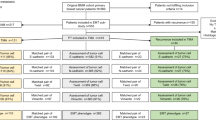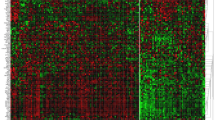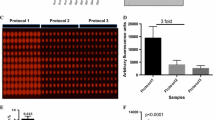Abstract
Epithelial mesenchymal transition (EMT), as defined by loss of epithelial characteristics and gain of a mesenchymal phenotype, has been reported in vivo although the occurrence of events remains unclear. This study aims at exploration of EMT portraits of breast cancer (BC) with relevance to different molecular pathways, especially potential EMT triggers and BC molecular subtypes. Immunohistochemical (IHC) expression of markers/triggers of EMT was studied on a well-defined cohort of invasive non-lobular BC (n = 1,035), prepared as tissue microarrays. IHC panel of biomarkers included cadherins (cad; E-cad and N-cad), TGFβ1, PIK3CA, pAkt, and others. Reverse phase protein array (RPPA) was performed for quantitative analysis of proteins extracted from formalin fixed paraffin embedded tissues of a subset of cases from this cohort. Four combinatorial phenotypic groups representing cadherin switch were defined, including E-cad+/N-cad−, E-cad−/N-cad−, E-cad+/N-cad+, and E-cad−/N-cad+. Statistically significant association was noticed between these phenotypes and histological tumour grade, tumour type and size and NPI staging classes. The E-cad/N-cad switch occurred more frequently in the triple negative molecular class, both basal and non-basal, and in the HER2+ subtype than in luminal BC. Significant outcome differences were observed between cadherin switch combinatorial groups regarding BCSS and DMFS (p < 0.001). Results of RPPA confirm those observed using IHC regarding differential expressions of EMT markers/triggers. EMT/cadherin switch programs in BC appear to occur in synergy with TGFβ1 and PIK3/Akt pathways activation. These data explain, at translational proteomic level, the molecular heterogeneity and in turn the varied clinical behaviour of BC molecular subtypes. RPPA is a promising high-throughput technique in monitoring subtle quantitative changes in protein expression in archival material.



Similar content being viewed by others
References
Thiery JP, Sleeman JP (2006) Complex networks orchestrate epithelial-mesenchymal transitions. Nat Rev Mol Cell Biol 7(2):131–142
Moustakas A, Heldin CH (2007) Signaling networks guiding epithelial-mesenchymal transitions during embryogenesis and cancer progression. Cancer Sci 98(10):1512–1520
Thiery JP (2002) Epithelial-mesenchymal transitions in tumour progression. Nat Rev Cancer 2(6):442–454
Iwatsuki M et al (2010) Epithelial-mesenchymal transition in cancer development and its clinical significance. Cancer Sci 101(2):293–299
Cardiff R (2010) The pathology of EMT in mouse mammary tumorigenesis. J Mammary Gland Biol Neoplasia 15(2):225–233
Tomaskovic-Crook E, Thompson EW, Thiery JP (2009) Epithelial to mesenchymal transition and breast cancer. Breast Cancer Res 11(6):213
Polyak K, Weinberg RA (2009) Transitions between epithelial and mesenchymal states: acquisition of malignant and stem cell traits. Nat Rev Cancer 9(4):265–273
Wu Y, Zhou BP (2008) New insights of epithelial-mesenchymal transition in cancer metastasis. Acta Biochim Biophys Sin (Shanghai) 40(7):643–650
Xue C et al (2003) The gatekeeper effect of epithelial-mesenchymal transition regulates the frequency of breast cancer metastasis. Cancer Res 63(12):3386–3394
Giampieri S et al (2009) Localized and reversible TGF[beta] signalling switches breast cancer cells from cohesive to single cell motility. Nat Cell Biol 11(11):1287–1296
Tarin D (2005) The fallacy of epithelial mesenchymal transition in neoplasia. Cancer Res 65(14):5996–6001
Wicki A et al (2006) Tumor invasion in the absence of epithelial-mesenchymal transition: podoplanin-mediated remodeling of the actin cytoskeleton. Cancer Cell 9(4):261–272
Tse JC, Kalluri R (2007) Mechanisms of metastasis: epithelial-to-mesenchymal transition and contribution of tumor microenvironment. J Cell Biochem 101(4):816–829
Wendt MK, Smith JA, Schiemann WP (2010) Transforming growth factor-beta-induced epithelial-mesenchymal transition facilitates epidermal growth factor-dependent breast cancer progression. Oncogene 29(49):6485–6498
Yang J et al (2004) Twist, a master regulator of morphogenesis, plays an essential role in tumor metastasis. Cell 117(7):927–939
Lamouille S, Derynck R (2011) Emergence of the phosphoinositide 3-kinase-Akt-mammalian target of rapamycin axis in transforming growth factor-beta-induced epithelial-mesenchymal transition. Cells Tissues Organs 193(1–2):8–22
Albasri A et al (2009) C-terminal Tensin-like (CTEN) is an oncogene which alters cell motility possibly through repression of E-cadherin in colorectal cancer. J Pathol 218(1):57–65
Peinado H, Portillo F, Cano A (2004) Transcriptional regulation of cadherins during development and carcinogenesis. Int J Dev Biol 48(5–6):365–375
Hazan RB et al (2004) Cadherin switch in tumor progression. Ann N Y Acad Sci 1014:155–163
Ahmed N, Thompson EW, Quinn MA (2007) Epithelial-mesenchymal interconversions in normal ovarian surface epithelium and ovarian carcinomas: an exception to the norm. J Cell Physiol 213(3):581–588
Josson S et al (2010) Tumor-stromal interactions influence radiation sensitivity in epithelial-versus mesenchymal-like prostate cancer cells. J Oncol. doi:10.1155/2010/232831
Lin K et al (2010) The role of B-RAF mutations in melanoma and the induction of EMT via dysregulation of the NF-kappaB/Snail/RKIP/PTEN circuit. Genes Cancer 1(5):409–420
Sarrio D et al (2008) Epithelial-mesenchymal transition in breast cancer relates to the basal-like phenotype. Cancer Res 68(4):989–997
Spurrier B, Ramalingam S, Nishizuka S (2008) Reverse-phase protein lysate microarrays for cell signaling analysis. Nat Protoc 3(11):1796–1808
Speer R et al (2007) Development of reverse phase protein microarrays for clinical applications and patient-tailored therapy. Cancer Genomics Proteomics 4(3):157–164
Brase JC et al (2010) Increasing the sensitivity of reverse phase protein arrays by antibody-mediated signal amplification. Proteome Sci 8:36
Abd El-Rehim DM et al (2005) High-throughput protein expression analysis using tissue microarray technology of a large well-characterised series identifies biologically distinct classes of breast cancer confirming recent cDNA expression analyses. Int J Cancer 116(3):340–350
Rakha EA et al (2009) Triple-negative breast cancer: distinguishing between basal and nonbasal subtypes. Clin Cancer Res 15(7):2302–2310
Aleskandarany MA et al (2010) Growth fraction as a predictor of response to chemotherapy in node-negative breast cancer. Int J Cancer 126(7):1761–1769
Sasaki K et al (2009) Significance of twist expression and its association with E-cadherin in esophageal squamous cell carcinoma. J Exp Clin Cancer Res 28:158
Bryan RT, Tselepis C (2010) Cadherin switching and bladder cancer. J Urol 184(2):423–431
Yilmaz M, Christofori G (2010) Mechanisms of motility in metastasizing cells. Mol Cancer Res 8(5):629–642
McCarty KS Jr et al (1985) Estrogen receptor analyses. Correlation of biochemical and immunohistochemical methods using monoclonal antireceptor antibodies. Arch Pathol Lab Med 109(8):716–721
Nirmalan NJ et al (2009) Development and validation of a novel protein extraction methodology for quantitation of protein expression in formalin-fixed paraffin-embedded tissues using western blotting. J Pathol 217(4):497–506
Cheang MC et al (2008) Basal-like breast cancer defined by five biomarkers has superior prognostic value than triple-negative phenotype. Clin Cancer Res 14(5):1368–1376
Nguyen DX, Massague J (2007) Genetic determinants of cancer metastasis. Nat Rev Genet 8(5):341–352
Yoder BJ, Wilkinson EJ, Massoll NA (2007) Molecular and morphologic distinctions between infiltrating ductal and lobular carcinoma of the breast. Breast J 13(2):172–179
Ellis IO et al (2005) Pathology reporting of breast disease : a joint document incorporating the third edition of the NHS Breast Screening Programme’s Guidelines for pathology reporting in breast cancer screening and the second edition of the Royal College of Pathologists’ minimum dataset for breast cancer histopathology. In: NHS Cancer Screening Programmes, Royal College of Pathologists, London
Marginean F et al (2010) Histological features of medullary carcinoma and prognosis in triple-negative basal-like carcinomas of the breast. Mod Pathol 23(10):1357–1363
Aleskandarany M et al (2010) Epithelial mesenchymal transition in invasive breast carcinoma: molecular pathways and relation to molecular subtypes. J Pathol 222(S1):S1–S51
Mahler-Araujo B et al (2008) Reduction of E-cadherin expression is associated with non-lobular breast carcinomas of basal-like and triple negative phenotype. J Clin Pathol 61(5):615–620
Acknowledgments
Ola H Negm and M. AH Ahmed are funded by the Egyptian Ministry of High Education.
Conflict of interest
The authors declare that they have no conflict of interest.
Author information
Authors and Affiliations
Corresponding author
Rights and permissions
About this article
Cite this article
Aleskandarany, M.A., Negm, O.H., Green, A.R. et al. Epithelial mesenchymal transition in early invasive breast cancer: an immunohistochemical and reverse phase protein array study. Breast Cancer Res Treat 145, 339–348 (2014). https://doi.org/10.1007/s10549-014-2927-5
Received:
Accepted:
Published:
Issue Date:
DOI: https://doi.org/10.1007/s10549-014-2927-5




